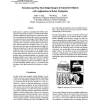Free Online Productivity Tools
i2Speak
i2Symbol
i2OCR
iTex2Img
iWeb2Print
iWeb2Shot
i2Type
iPdf2Split
iPdf2Merge
i2Bopomofo
i2Arabic
i2Style
i2Image
i2PDF
iLatex2Rtf
Sci2ools
ICRA
2003
IEEE
2003
IEEE
Structure and pose from single images of symmetric objects with applications to robot navigation
In this paper, we provide a principled and unified explanation how knowledge in global 3-D structural invariants, typically captured by a group action on a symmetric structure, can significantly facilitate the task of reconstructing a 3-D scene from one or more images. More importantly, the “absolute” pose between the camera frame and the canonical frame that a symmetric structure admits can he recovered, which explains why symmetric objects (e.g., huildings, hallways) provide us overwhelmingclues to their orientation and position. We give the necessary and sufficient conditions under which this pose can he uniquely determined, and, when such conditionsare not satisfied, exactly to what extent this pose can be recovered. We show how algorithms from conventional multiple-view geometry, after properly modified and extended,can he effectively applied to perform such recovery. Since now structure, pose and even camera calibration can he recovered from a single image, the techniques na...
3-D Structural Invariants | ICRA 2003 | Robotics | Symmetric Structure | Symmetric Structure Admits |
| Added | 04 Jul 2010 |
| Updated | 04 Jul 2010 |
| Type | Conference |
| Year | 2003 |
| Where | ICRA |
| Authors | Allen Y. Yang, Wei Hong, Yi Ma |
Comments (0)

